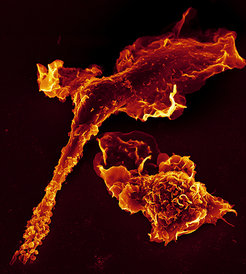Eavesdropping on Immune Cells - Max Planck Scientists Analyze How the Immune System Communicates
When pathogens such as bacteria or viruses invade the human body, different immune cells must work together and coordinate their defense strategies with each other. Using newly developed proteomics technologies, scientists of the Max Planck Institute (MPI) of Biochemistry in Martinsried near Munich, Germany, have now comprehensively detected the messenger proteins secreted by immune cells during such an immune response. “Our method enables an analysis of the information exchange between cells and provides a powerful tool to understand the language of our immune system in the context of disease,” said Felix Meissner, scientist at the MPI of Biochemistry. The results of the study, which was carried out in collaboration with colleagues from the MPI for Infection Biology in Berlin, have now been published in Science.

People communicate through the spoken word. When cells communicate with each other, they secrete special proteins that serve as messengers and can be recognized by other cells. These messenger proteins enable the dissemination of information in the body and can thus control and coordinate complex processes such as defense reactions against pathogens. Previous analyses have focused on single messenger proteins or a small selection of these. Scientists from the Proteomics Department of Matthias Mann have developed a novel mass spectrometry-based method to comprehensively analyze the information exchange between immune cells.
For this study the scientists used macrophages, a particular cell type of the immune system. These cells act as the body’s first line of defense against pathogens. Macrophages (literally “big eaters” in Greek) devour and digest harmful bacteria and viruses. Another task of the cells is to attract other immune cells to the site of the incident. To do so, they secrete messenger proteins.
Attentive listening
To elicit a similar reaction as in the body, the scientists mimicked an infection by exposing the macrophages to a bacterial compound. Then they isolated the proteins secreted by the macrophages and analyzed these using a mass spectrometer. They identified more than 50 already known messenger proteins and in addition several hundred proteins not previously known to be involved in the communication between immune cells. The MPI researchers were also able to classify the identified messenger proteins into groups with different immunological functions. “Our approach enables a better understanding of intercellular communication,” said Felix Meissner. “We can now listen to all arguments immune cells use to exchange information with each other and not just the ones we like to hear.”
Original publication:
Meissner, F., Scheltema, R.A., Mollenkopf, H.J. and Mann, M.: Direct Proteomic Quantification of the Secretome of Activated Immune Cells. Science, April 26, 2013.
DOI: 10.1126/science.1232578


